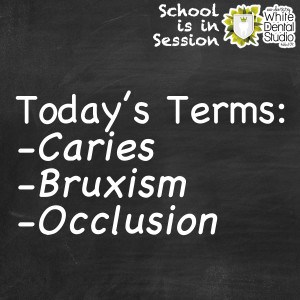 “What the heck is my dentist talking about?! Sometimes I feel like I need a dental dictionary!”
“What the heck is my dentist talking about?! Sometimes I feel like I need a dental dictionary!”
Recently my wife came across some language related to dentistry which she found intriguing, and that got us thinking: What are some terms we use in dentistry that our patients have never heard of? Let’s begin simply. Pretty much everyone knows that decay or cavity means there is a hole in the tooth from bacterial consumption of the enamel and dentin which needs to be filled. The appropriate diagnosed condition is dental caries. An interesting word, to say the least. The caries process is currently the most prevalent chronic disease in children and adults. Let that soak in for a minute… decayed teeth is a disease! Even more interesting than the word caries is the preventable nature of the disease. Proper home care with brushing, flossing, proper use of fluoridated pastes/rinses/flosses combined with a scheduled preventive plan with a dental health care provider dramatically reduces caries risk, which in turn reduces cost, discomfort, and time away from family and work. It’s important to note that patients who prefer non-fluoridated products aren’t left holding the bag, as there are numerous rinses and toothpastes which may also prove effective if used properly. Examples are XyliWhite Toothpastes (comes fluoridated and non-fluoridated, and is also Sodium Lauryl Sulfate free) and Tooth and Gum Tonic by the Dental Herb Company.
How about another interesting dental term? Bruxism – the encompassing term for grinding, clenching, and gnashing of teeth. The process can occur during the day, often as a habit or related to stress. For many, bruxing is a nocturnal occurrence, many times going unnoticed. Children who develop a bruxing habit are often compensating for teething discomfort, and we often monitor the habit unless it is aggressively wearing teeth down. Adults often clench or grind during periods of high anxiety/stress and as a coping mechanism to focus. Occlusion (how the teeth and jaws align) can also be related to bruxing. Some medications and ailments such as Parkinson’s Disease may also be related to bruxism. Splint therapy, where a dentist fabricates an appliance to protect the teeth and prevent damage, is often a first line of treatment. As cases progress via wear to the dentition, including existing fillings or crowns, rehabilitation may become necessary through corrective orthodontics, oral surgery, or fabrication of “new” teeth coverings with metal or high-strength ceramic materials. Research is ongoing for the effectiveness of treating bruxism with medications including muscle relaxants and Botox, while stress management and behavioral therapy management may prove beneficial to some. Alcohol, caffeine, and illicit drugs like Methamphetamine and MDMA (Ecstasy/Molly) will also exacerbate a bruxing habit. Clearly, illicit drugs should be avoided but it is interesting to note the stimulation of bruxism which can be brought on by a stimulant such as caffeine as well as a what we perceive to be a depressant in alcohol. In excess, alcohol can become disinhibiting resulting in rage, anger, agitation, and violence. One can easily see how under those situations clenching and gnashing of the teeth is more likely to occur. Are you at risk of dental caries or bruxism? Ask your dentist, form a plan, adapt the plan over time and as situations change, and pave the way to dental health!
Sources: ADA and Mayo Clinics
Post written by Dr. Brandon White, White Dental Studio, Ashland, OR

Recent Comments